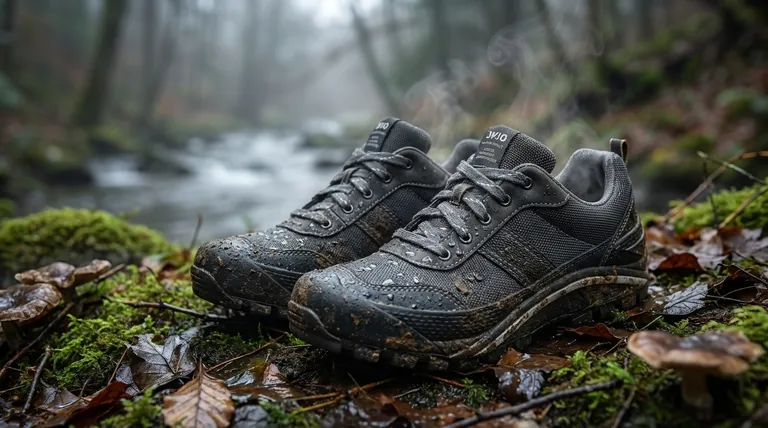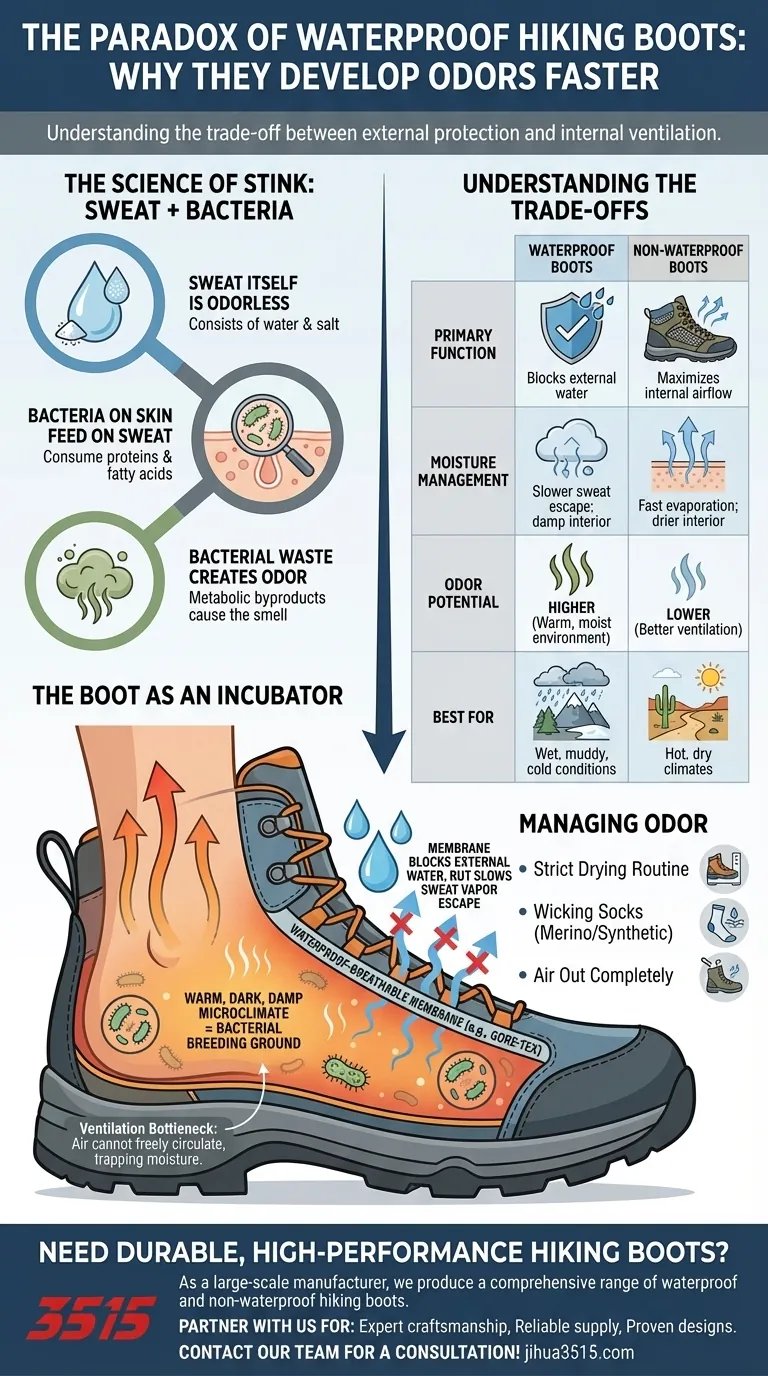It’s a frustrating paradox: the very technology designed to protect your feet from water is often what makes them smell worse. Waterproof hiking boots develop odors faster because their water-blocking membranes inherently reduce air circulation, trapping sweat and creating a warm, damp internal environment that is an ideal breeding ground for odor-causing bacteria.
The core issue is a trade-off between external protection and internal ventilation. Waterproofing keeps rain and puddles out, but it also significantly slows the escape of sweat vapor, fueling the bacteria that create odor.

The Science of Stink: Sweat, Bacteria, and Your Boots
To understand why waterproof boots are particularly susceptible to odor, you first need to understand what causes the smell in the first place. It’s a simple, three-part formula.
Sweat Itself Doesn't Smell
Your feet have over 250,000 sweat glands, more per square inch than any other part of your body. However, the sweat they produce is initially odorless, consisting mostly of water and salt.
Bacteria's Favorite Meal
The smell is not caused by sweat, but by bacteria. Naturally occurring bacteria on your skin consume the trace amounts of proteins and fatty acids in your sweat, and their metabolic waste products are what create the unpleasant odor.
The Boot as an Incubator
Bacteria thrive in warm, dark, and moist conditions. A hiking boot on your foot during a long walk provides the perfect incubator, offering warmth from your body, darkness, and a constant supply of moisture (sweat) and food (dead skin cells).
How Waterproofing Technology Creates the Problem
The key difference between waterproof and non-waterproof boots lies in how they manage moisture. This difference is centered on a specialized layer inside the boot.
The Waterproof-Breathable Membrane
Modern waterproof boots almost always use a waterproof-breathable membrane, like GORE-TEX or a proprietary equivalent. This is a remarkable piece of technology with microscopic pores.
These pores are small enough to block large liquid water droplets (like rain or puddle water) from getting in, but large enough to theoretically allow smaller water vapor molecules (your sweat) to escape.
The Limits of "Breathability"
Herein lies the problem. "Breathable" is a relative term. While these membranes do allow some sweat vapor to escape, they cannot transport moisture out as quickly as your foot produces it during strenuous hiking.
The rate of evaporation is simply much slower than it would be through the open mesh of a non-waterproof trail runner. Air cannot freely circulate to carry the moisture away.
The Result: A Damp Microclimate
This ventilation bottleneck means that a significant amount of moisture remains trapped inside your waterproof boot. This creates a consistently damp microclimate that allows odor-causing bacteria to multiply far more rapidly than they would in a drier, more ventilated boot.
Understanding the Trade-offs
Choosing hiking footwear is not about finding a perfect boot, but about understanding the compromises required for your specific environment and activity.
Protection vs. Ventilation
This is the fundamental trade-off. Waterproof boots prioritize protection from external elements (rain, snow, stream crossings) at the cost of internal ventilation. Non-waterproof boots prioritize ventilation at the cost of protection from external water.
When Waterproof is the Right Call
For hiking in consistently wet, muddy, or snowy conditions, the protection offered by a waterproof boot is indispensable. Wet feet can quickly lead to blisters, discomfort, and even hypothermia in cold weather. In these cases, managing odor is a secondary concern to keeping your feet dry and safe.
When Non-Waterproof is Better
For hiking in predominantly hot and dry climates, a non-waterproof, highly breathable boot or trail runner is almost always the superior choice. It will allow sweat to evaporate quickly, keeping your feet cooler, drier from the inside, and less prone to odor and blisters caused by internal moisture.
Managing Odor in Your Hiking Boots
Regardless of your choice, you can take steps to control the internal environment of your boots and minimize odor.
- If your primary focus is protection in wet conditions: Choose a quality waterproof boot, but commit to a strict drying routine. Remove the insoles after every hike and allow the boots to air out completely, using a boot dryer if necessary.
- If your primary focus is comfort in hot, dry climates: Opt for non-waterproof, highly breathable trail runners. Your feet will get wet if you cross a stream, but they will also dry out exceptionally fast.
- For all hikers, regardless of boot choice: Wear moisture-wicking socks made from merino wool or synthetic materials. Avoid cotton at all costs, as it absorbs and holds moisture against your skin.
Ultimately, understanding the mechanics of moisture management empowers you to select the right footwear and care for it properly.
Summary Table:
| Factor | Waterproof Boots | Non-Waterproof Boots |
|---|---|---|
| Primary Function | Blocks external water (rain, puddles) | Maximizes internal airflow and breathability |
| Moisture Management | Slower sweat vapor escape; damp interior | Fast evaporation; drier interior |
| Odor Potential | Higher (warm, moist, dark environment) | Lower (better ventilation) |
| Best For | Wet, muddy, cold conditions | Hot, dry climates and fast-drying needs |
Need Durable, High-Performance Hiking Boots for Your Customers?
As a large-scale manufacturer, 3515 produces a comprehensive range of waterproof and non-waterproof hiking boots for distributors, brand owners, and bulk clients. We understand the precise balance between protection, breathability, and comfort.
Partner with us to offer your customers:
- Expertly crafted footwear using advanced materials and membranes.
- Reliable supply and customization options to meet your market's needs.
- Proven designs built for durability and performance on the trail.
Let's discuss how our production capabilities can enhance your product line. Contact our team today for a consultation!
Visual Guide

Related Products
- Durable Rubber Sole Outdoor Shoes Wholesale & Custom Manufacturing
- Safety Footwear Wholesale Manufacturer for Custom OEM/ODM Production
- Durable Waterproof Rain Boots | Custom Manufacturer for Wholesale & Brands
- Wholesale Premium Waterproof Nubuck Safety Shoes Boots
- Premium Wholesale Waterproof Safety Boots High Performance Protection for Industrial Markets
People Also Ask
- How does cushioning work in hiking shoes? The Science of Shock Absorption
- What are the main applications of vulcanized rubber? Unlock Durability for Tires, Footwear & More
- Why are vulcanized soles popular in urban fashion? Discover the Legacy of Authentic Street Style
- How do hiking shoes or boots protect feet from environmental hazards? A Guide to Trail-Ready Footwear
- What were traditional shoe soles made from before rubber? The History of Leather Soles



















